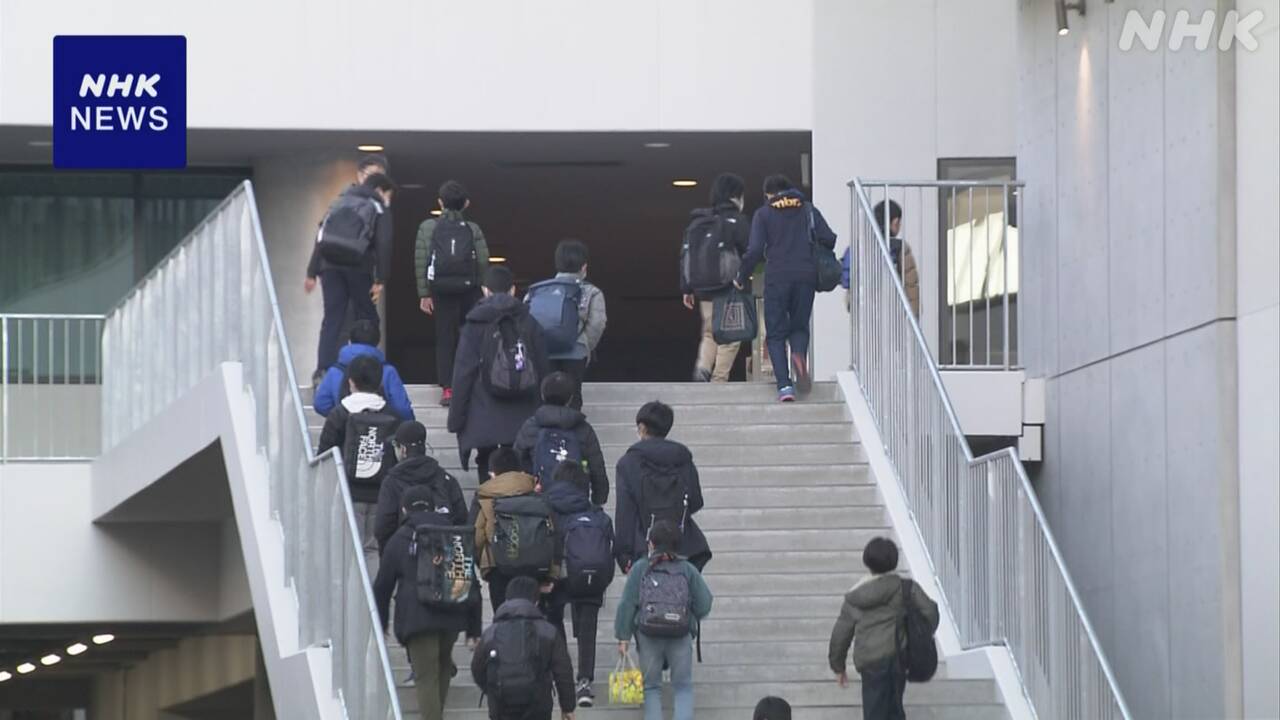With the number of junior high school applicants in the Tokyo metropolitan area expected to reach a record high, entrance exams began on the 1st in Tokyo and Kanagawa, where private junior high schools are concentrated.
Junior high school entrance exams in the Tokyo metropolitan area began last month in Saitama and Chiba, and on the 1st began in Tokyo and Kanagawa, where a total of about 250 private junior high schools are concentrated.
Among these students, examinees and their parents began arriving one after another at Kaisei Junior High School in Arakawa Ward, Tokyo, starting around 7 a.m.
After checking to see if they had forgotten anything and taking the time to review their reference books, the students entered the school building after being cheered on by their parents.
One of the test takers said enthusiastically, ``I'm good at math and enjoy logical problems.I used to study for about 10 hours a day at most.I definitely want to pass.''
The mother of another examinee said, ``This year, she often took off her mask, so she has been careful about her health. She has worked hard so far, so I hope she achieves results.'' Ta.
According to the Tokyo Metropolitan Area Mock Test Center, 52,600 people took the exam last year, mainly in Tokyo and three prefectures, the highest number ever, due to the popularity of private junior high schools that offer a variety of curricula such as global education and science education. Therefore, it is expected that this year will remain at about the same scale.
Junior high school entrance exams in the Tokyo metropolitan area are at their peak until around the 5th.
Expanding various entrance examination methods to develop abilities that are not based solely on scores
For junior high school entrance exams, an increasing number of private junior high schools are introducing a variety of entrance exam methods in order to accept a diverse range of students, and there is a growing movement to assess students' abilities beyond just paper test scores.
Of these, Hosen Gakuen Junior High School Science and Mathematics Interchange in Nakano Ward, Tokyo, features inquiry-based classes in which students think about unanswered questions. We have introduced 12 entrance examination methods.
In addition to the traditional entrance exams based on paper tests such as arithmetic and Japanese, there are entrance exams where you present what you have learned and what you are good at, inquiry-type entrance exams where you deepen your group discussion on a certain theme, and "Reading Entrance Exams" where you introduce your favorite books. We are implementing new entrance exams such as the ``Presentation Entrance Exam'' where multiple faculty members evaluate students' ability to express their ideas in their own words and their communication skills.
The students who took the exam last year used their experience of growing pesticide-free vegetables to vividly present the types of pests they had, how they exterminated them through trial and error, and the differences in growth when they brought the vegetables they had harvested.
After that, I expressed my desire to utilize IT technology to prevent pests and spread the use of pesticide-free vegetables, and was accepted and enrolled.
Approximately 10% of students enter the university through these entrance exams each year, and some take the entrance exam as an extension of pursuing something that interests them, rather than studying specifically for the entrance exam.
Some of the students even started their own businesses while in school.
Teacher Takashi Yonezawa, head of the Entrance Examination Public Relations Department, said, ``Generally speaking, junior high school entrance exams are based on academic ability and are passed from top to bottom, but children's abilities are not limited to that. I believe that we can grow by learning and gaining new insights while being inspired by each other."
How did the school respond to students who missed elementary school to study for entrance exams?
According to the Tokyo Metropolitan Board of Education, the percentage of children who graduated from public elementary schools in Tokyo last year who went on to private or national junior high schools exceeded 20%, a record high, and 40% in three wards. exceeded 30% in eight wards.
Under these circumstances, during the junior high school entrance exam season, many children miss elementary school to study for the entrance exam.
When we interviewed a local government with a high rate of admission to private junior high schools, we found that in one ward, approximately one-third of children have been absent since January due to reasons such as studying for entrance exams or taking care of their health. In some schools, about half of the students are absent on the second day.
The school takes into consideration the wishes of the students and their parents who have studied for a long time, and tells their parents that ``as it is before graduation, we want them to attend school as normally as possible,'' and that if they are absent, they can submit their homework after taking the exam. Therefore, we are taking care to submit it.
In another ward, when the absentee rate is high, there are not enough people to play games or hold group events in physical education classes, so two classes are held together, etc., so that they can be held as regularly as possible. This means that we are trying to make sure that the students can have a normal school life.
A person in charge of one of the ward's wards said, ``I can understand the decision of families to have their children absent as this coincides with the season when influenza and other diseases are prevalent.However, I have mixed feelings about this situation.''

